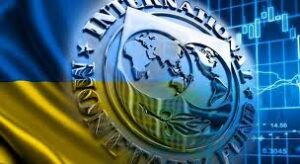
The International Monetary Fund (IMF) has clarified the forecast of Ukraine’s GDP growth in 2024 under the World Economic Outlook (WEO): it expects it at the level of 3.2%, then during the third revision of the EFF Extended Fund Facility program in March estimated it in the range of 3-4%.
According to a publication on the Fund’s website on Tuesday, the economic growth forecast for 2025 was kept at 6.5%, up from 5.3% in 2023, according to the State Statistics Service.
The IMF also expects average annual inflation to slow to 6.4% this year from 12.9% last year and accelerate slightly to 7.6% in 2025.
Ukraine’s current account deficit forecast for this year and next year has been kept at the same level as in the third revision of the EFF program – 5.7% of GDP and 8.2% of GDP after 5.5% of GDP last year.
The Fund also reiterated expectations for unemployment to fall from 19.1% last year to 14.5% this year and 13.8% next year/
The IMF indicated that it forecast growth in the euro zone to accelerate to 0.8% this year and 1.5% next year after 0.4% last year, driven by the strong impact of Russia’s war against Ukraine.
“Stronger household consumption as the impact of the energy price shock fades and lower inflation supports real income growth is expected to support the recovery,” the Fund said, clarifying that the updated estimate is 0.1-0.2 percentage points (p.p.) worse than the previous estimate made in January.
Overall, the WEO said global economic growth, estimated at 3.2% in 2023, will continue at the same pace in 2024 and 2025. The forecast for 2024 is revised upward by 0.1pc from the January estimate.
“These growth rates are low by historical standards, driven by both short-term factors, such as continued high borrowing costs and the withdrawal of fiscal support, and the longer-term effects of the COVID-19 pandemic and Russia’s invasion of Ukraine, weak productivity growth, and increased geoeconomic fragmentation,” the IMF said.
Overall global inflation is expected to decline from an annual average of 6.8% in 2023 to 5.9% in 2024 and 4.5% in 2025, with advanced economies returning to their inflation targets sooner than emerging market and developing countries.
The report also notes that the forecast for global economic growth in five years’ time (at 3.1%) is the lowest in decades. ” An alarming change is the widening gap between many low-income countries and the rest of the world. The growth forecast for these economies has been revised downward and the inflation forecast has been raised,” the Fund states.
Worse still, the report notes that compared to most other regions, estimates of long-term damage for low-income developing countries, including some large countries, are revised upward, indicating that the poorest countries are still unable to recover from the pandemic and cost-of-living crisis.
Its experts attribute the relatively weak medium-term outlook to lower GDP per capita growth, due in part to persistent structural frictions preventing the movement of capital and labor to productive firms. And worsening growth prospects in China and other large emerging market economies, given their growing share in the global economy, will have a negative impact on the development prospects of their trading partners.
According to the IMF, the risks to the global economic outlook are currently balanced. “On the downside, new price spikes triggered by geopolitical tensions, including from the war in Ukraine and the conflict in Gaza and Israel, could, along with the resilience of core inflation while labor markets remain tight, lead to higher interest rate expectations and lower asset prices,” the WEO pointed out.
The fund added that geo-economic fragmentation could intensify, with higher barriers to the flow of goods, capital and people implying slower economic growth due to lower supply.
At the same time, it noted that artificial intelligence and stronger structural reforms than expected could boost productivity growth.
As the global economy approaches a soft landing, the priority for central banks in the short term is to ensure that inflation falls smoothly, avoiding both premature policy easing and excessive delay leading to lagging behind targets, the IMF also said.
“Multilateral cooperation is needed to limit the costs and risks associated with geoeconomic fragmentation and climate change, accelerate the transition to green energy, and facilitate debt restructuring,” the Fund concluded.
More details on macroeconomic indicators of Ukraine and the world, GDP of major countries and other economic topics were discussed in one of the video analysis of Experts club analytical center – https://youtu.be/w5fF_GYyrIc?si=Ymo-FlMFNGfLLdK-.
Subscribe to Experts club channel here: https://www.youtube.com/@ExpertsClub
EXPERTS CLUB, GDP GROWTH, IMF, MACROECONOMICS, UKRAINE, URAKIN

The real gross domestic product (GDP) of Ukraine in the third quarter of 2021 increased by 2.7% compared to the same period in 2020, the State Statistics Service reported such an updated estimate, while earlier it estimated growth in mid-November at 2.4%. According to its data, nominal GDP amounted to UAH 1.498 trillion, and per capita – UAH 36,150.
The State Statistics Service added that compared with the previous quarter (taking into account the seasonal factor), GDP grew by 1.5%, which is slightly better than the preliminary estimate of 1.4%.
The statistics department clarified that the change in the deflator was 25.5%, compared with 26.4% in the second quarter and 20.7% in the first quarter of this year.
In September, the State Statistics Service also improved its estimate of the growth of the Ukrainian economy in the second quarter of this year – from 5.4% to 5.7% and set the nominal GDP at UAH 1.169 trillion.
Whereas in June, the department, on the contrary, worsened the estimate of recession of the Ukrainian economy in the first quarter of this year – from 2% to 2.2%, calculating the nominal GDP at the level of UAH 1.009 trillion.
According to the department, in the first quarter of 2020 the decline was 1.2% compared to the first quarter of 2019, in the second quarter of last year it accelerated to 11.2%, after which it slowed down to 3.5% in the third quarter and 0.5% – in the fourth.
Nominal GDP in the first quarter of last year was UAH 853.69 billion (deflator change – 5.3%), in the second – UAH 874.62 billion (5.6%), in the third – UAH 1.162 trillion (8.4%), in the fourth – UAH 1.301 trillion (17.5%).

Oxford Economics has improved its forecast for Ukraine’s real GDP growth in 2021 to 4.9%, up from 4% in the February forecast.
As evidenced by the May forecast, which is available to Interfax-Ukraine, the analysts have worsened their expectations for the growth of the Ukrainian economy in 2022 to 3.7% compared to the February forecast being 4.2%, and in 2023 they expect the decline in rates to continue – growth to 2.9%.
Strong growth in industrial production in April, a year after a series of lockdowns, marks a turning point that will see GDP grow by almost 5% this year, and then just over 3.5% in 2022, Oxford Economics said.
At the same time, the average annual hryvnia exchange rate in 2021 is expected at UAH 28.60/$1, in 2022 – UAH 29.30/$1, in 2023 – UAH 29.40/$1, according to Oxford Economics.
The analysts have raised their inflation forecast to 7.2% this year (in the February forecast it was 6.9%), and in the next two years they expect prices to rise by 4.9% and 5.2%, respectively.
The analysts continue to expect the current account to return to a deficit of 1.5% of GDP this year, while in 2020 the current account surplus reached 4% of GDP. According to their estimates, in 2022 and 2023 this indicator will remain in deficit and will amount to 2% and 1.7%, respectively.
Private investment is projected to recover cautiously, so the recovery will be more dependent on household and government spending. However, rising demand will push companies to further expand their production capacity from 2022.
Oxford Economics expects the budget deficit this year to be 4.6%, and in 2022 and 2023 it will decrease to 3.2% and 3.4%, respectively.
At the same time, the analysts predict a reduction in the ratio between public debt and GDP from 59.2% in 2020 to 56% in 2021, as well as to 52.4% and 49.7% in the next two years.
Oxford Economics expects Ukraine to be able to unlock the IMF program in the third quarter of 2021. At the same time, political risks remain high, according to the forecast.

The Ministry of Economic Development and Trade and the Ministry of Finance of Ukraine expect the country’s GDP will grow by 3.6% in 2019. The corresponding forecast is contained in the draft titled “Main Guidelines of Budget Policy” submitted by the Cabinet of Ministers on Wednesday. The growth of the consumer price index (inflation) by the end of 2019 is expected at 6.5%, the average annual forex rate of the hryvnia against the U.S. dollar is projected at UAH 30.5.
Earlier it was reported that the National Bank of Ukraine predicts the acceleration of GDP growth in 2018 to 3.4% from 2.5% in 2017 and a slowdown in 2019-2020 to 2.9%.
Regarding the consumer price index, the NBU expects inflation to slow to 8.9% by the end of 2018 from 13.7% in 2017, while a forecast for 2019 is set at 5.8%, in 2020 at to 5%.